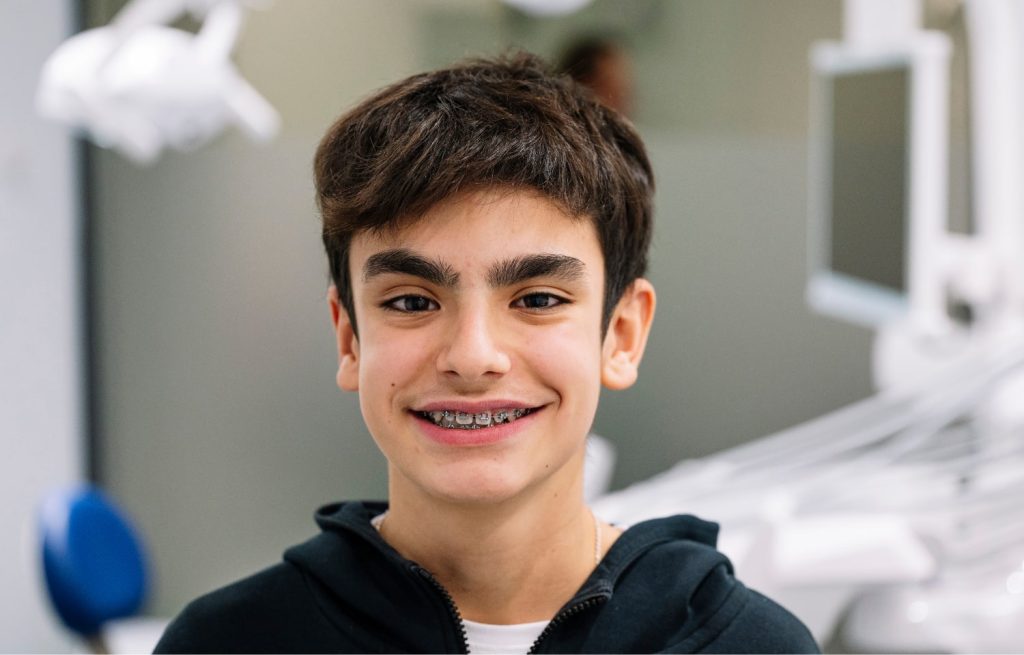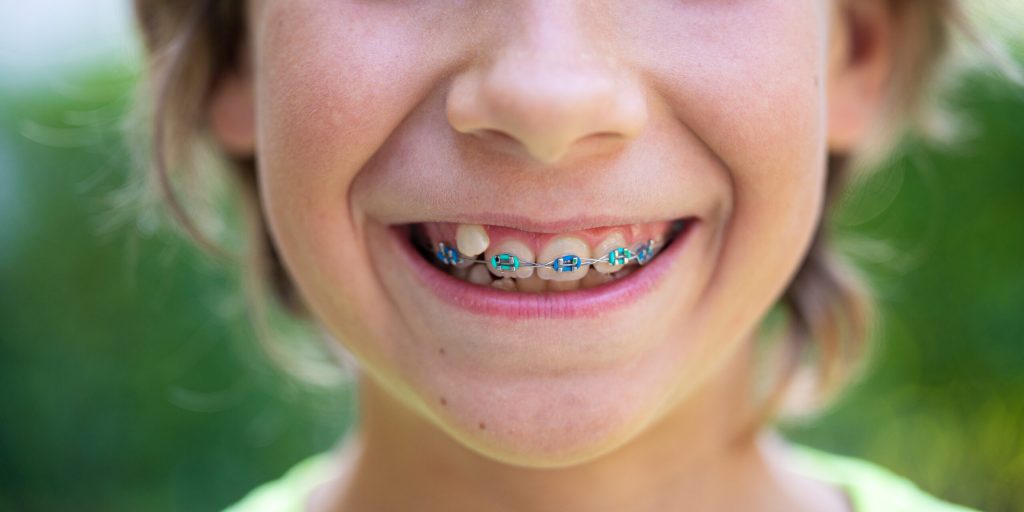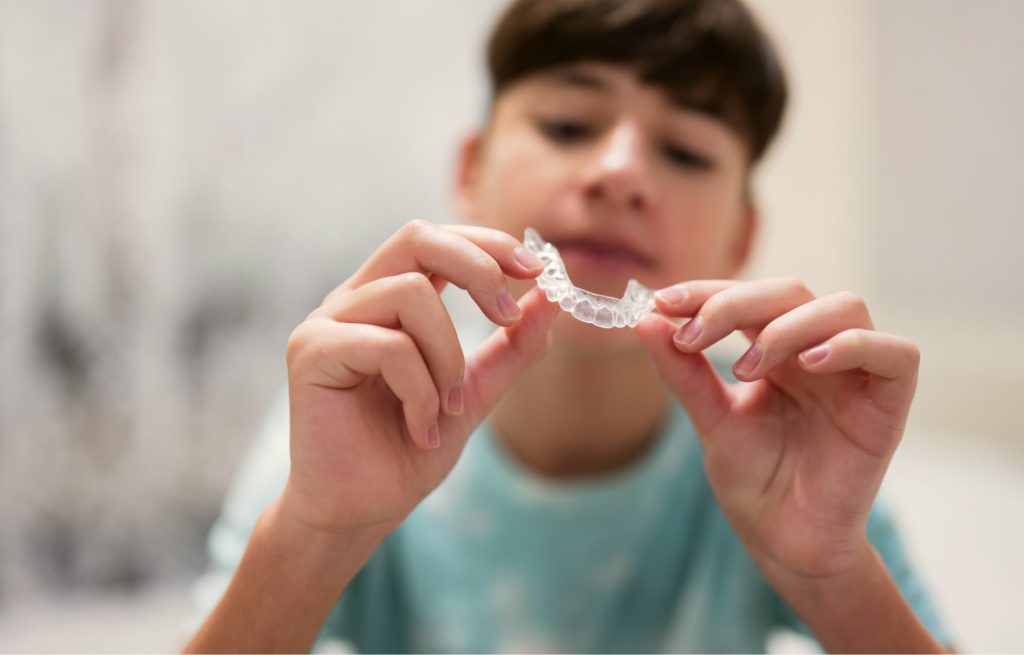Children’s Braces: Understanding the Process and Benefits
15 Jul 2024
It’s hard enough being a teenager without having to worry about your teeth. At that age, their mouths are growing incredibly quickly while their teeth work their way into their final positions.
A good smile can help soothe some of the other anxieties of growing up. One of the biggest concerns affecting young people’s dental health is ensuring that their teeth are straight and aligned. The best way to fix any problems is through children’s braces.
This concern is more than simply appearance-based. Misaligned teeth can cause tooth decay, gum diseases, speech problems, eating problems, and even loss of bone in the jaw.
Correction is more than just a luxury, it’s essential for protecting your children’s health.
So, what sort of kid’s braces are available and how can they help? What are the steps for fitting children’s dental braces? How much do children’s braces cost?
Below we look at these questions in detail so that you can understand what it takes to give your children a smile they can feel completely comfortable showing the world.
How do you know if your child needs braces?

As a general rule, your children should see a dentist by the age of 7. This is the recommendation from the American Association of Orthodontists. The evaluation will tell you for sure if children’s braces are needed.
However, there are often signs that you can pick up on ahead of the evaluation. If you notice that your child’s teeth are crowded, coming through at an angle, or in the wrong place, these are often clear signs that children’s teeth braces will be needed. They may find it difficult to bite down on certain food, or chewing may be painful or difficult. The time that they lose their baby teeth can also be a factor. Losing baby teeth either early or late can also be a factor, so it’s worth keeping track of this too.
Common Problems with Children’s Teeth
There are many causes of problems with children’s teeth, and unfortunately, not all of them can be prevented. Genetics plays a crucial role in our development, and this is no different for children’s teeth. They can dictate positioning and the rate at which baby teeth fall out.
Other things can impact tooth placement which can be prevented, such as thumb sucking or overfeeding with a bottle.
Whatever the reason, fitting children’s braces is an easy and early solution that can massively improve the dental health of your kids.
Misaligned teeth can be a real problem, leading to gum disease and tooth decay. In more severe cases, kids can develop problems with their speech.
Fixing these problems early can save a lot of pain (and a lot of money) later on.
What is an Orthodontist?
Simply put, an orthodontist is a specialist in correcting problems with the teeth and jaw. They have exactly the same level qualifications as a general dentist (sometimes even more) but will have experience and equipment to help with tooth alignment problems and fit children’s dental braces.

What happens during consultations with the Orthodontist?
The very first thing that Dr. Bosse will do is an examination. The point of this is to look at your child’s mouth, specifically their teeth, jaw, and bite. This is a physical examination but can often include X-rays or molds as well.
Following the initial examination, there will be a discussion to look at which treatments are the most appropriate. Children’s braces are common and effective, but there are many other treatment options that can be considered.
Often the key decider is the extent to which the teeth are misaligned. Part of this part of the process will be to provide a detailed timeline and plan, tailored to your child, explaining each step and how and why it’s important to the process.
These steps will help you understand the process and also enable you to educate your children. This can be useful when they get a little older and may want to understand more about why children’s dental braces are important.
Types of Pediatric Braces

Traditional Metal Braces
When you think about kid’s braces, these are the most recognizable types. They are a series of metal brackets that support wires. They can be loosened or tightened based on the alignment that needs to happen.
These are very effective and work for many problems with the teeth and jaw. They’re also difficult to break, which makes them the perfect children’s braces – especially when they’re younger.
The only downside is that they are visible, which can lead to more resistance when kids turn into teenagers and looks become more important. On the other hand, they’re very effective and very affordable.
Ceramic Braces
Orthodontists can offer ceramic braces for patients who are more interested in a solution that looks natural. These are clear or can be made to match the color of your children’s teeth. They are very popular among teenagers keen to impress as they are more subtle and look more natural.
Due to the material used to create ceramic braces, they are more prone to wear and tear, break more easily, and are prone to staining. They are not as strong as metal braces, which means that treatment can take a little longer (although due to their natural color and subtlety, this may not be as much of a concern).
Lingual Braces
Lingual braces are a type of children’s braces attached to the back of the teeth. They are invisible from the front and offer the same benefits as metal braces.
For teenagers, the lack of visibility is essential while the fact that the braces are metal decreases the treatment time and lessens the chance they may become damaged.
They can be more expensive, however, and due to their placement inside the mouth, they can cause discomfort initially. Thanks to the interaction between the brace and the tongue, speech may be adjusted.

Invisalign
A modern technology that is custom-designed children’s braces. They’re made from a clear thermoplastic, making them nearly invisible against the teeth.
They are custom-made using 3D imaging technology. They are much less obvious than other types of children’s braces. They can also be removed and replaced easily for eating and drinking. Due to the custom process, they provide precise and predictable results. They tend to be more comfortable as they align with the natural shape of the teeth.
However, they require discipline as they need to be worn at least 20 hours a day. They are also not suitable for more complex alignment issues.
The Process of Getting Children’s Braces
The good news is, whatever the problem might be and whatever the treatment, Greenspoint Dental has a simple, easy, and cost-effective process to ensure that you have the perfect treatment plan that takes into account the needs (and feelings) of your children.
Initial Consultation: An examination of your children’s mouth. It can be physical, x-ray, or mold-based. The examination is followed by a discussion of the best route, taking into account your preferences as well as the most effective treatment.
Molding and Fitting: Using a mold, we will replicate your child’s mouth so that we can build a custom-fitted brace. These are then carefully fitted after a comprehensive cleaning.
Adjustment and maintenance: every 4 -8 weeks we will schedule a follow-up. This includes tightening or replacing wires to ensure that the treatment remains effective. It’s also an opportunity to ensure and educate your child on oral hygiene.
Benefits and Drawbacks of Children’s Braces
Advantages of Children’s Braces
Children’s braces improve confidence and dramatically impact your children’s oral health:
- Kid’s braces provide a straighter, more natural smile.
- They make it easier to clean your teeth, reducing decay and gum disease
- They make it easier to bite, chew and speak
- They reduce future complications like bone loss in the jaw
- Dental braces save on costs by reducing the potential for complex and expensive issues in the future.
Potential Disadvantages
There are many reasons to provide braces for your children, but they do come with some downsides that are worth considering and discussing:
- There is initial discomfort, which can cause pain and irritation.
- They must be disciplined in maintaining oral hygiene and keeping their teeth clean, which can be problematic for younger kids.
- Braces may impact speech for a time, meaning adjusting may take a while.
- When visible, they can impact some children’s self-esteem.
Addressing Concerns
Luckily, there are lots of resources available to support you while considering braces for your children. The more active you are as a parent in the process, the better the results and the more confidence your children will have.
For example, regular check-ups are the best way to ensure that treatment progresses as we want. Ensuring oral hygiene is a great thing to instill young and will save you (and eventually them!) a lot of money in the future.
For potential speech issues, we can recommend options such as speech therapy or exercises. Both of these will dramatically impact helping overcome initial challenges with braces.
By working together and ensuring open and honest communication, you can soothe your children’s anxiety before it becomes a problem.
What can Greenspoint Dental Do to Help Your Child with Their Braces?
Braces are an essential early step to having a life of good oral health. At Greenspoint Dental, we offer different braces and assist throughout the whole process, as well as with hygiene and regular check-ups. The best way to learn about braces and which type might be the most suitable is to come and see us. In person, we can assess your child’s teeth and discuss your options for which braces will work best for your lifestyle and budget.
Seeing us early can save you a lot of pain and expensive treatment later. We know coming to the dentist can be stressful, so we focus on patient-centric, comfort-focused care.
We accept many different dental insurance plans, like CareCredit, Lending Club, and the HELPcard. Please call (281) 823-9987 today or click here to contact us for a consultation.
Related Blog Articles